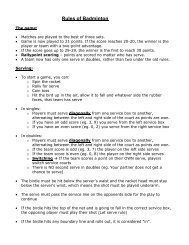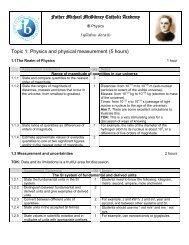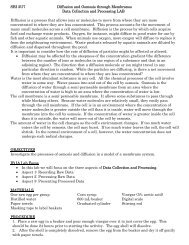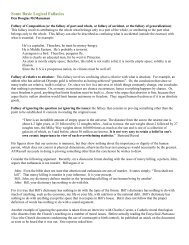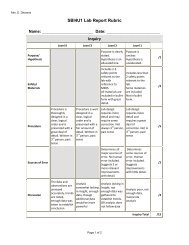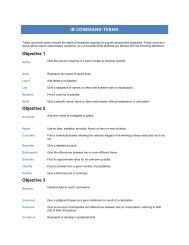Inductive Reasoning
Inductive Reasoning
Inductive Reasoning
Create successful ePaper yourself
Turn your PDF publications into a flip-book with our unique Google optimized e-Paper software.
<strong>Inductive</strong> Arguments (Inferences)Induction is a very important part of logic. So much of our knowledge in the sciences is a result of induction. Induction isdifferent from deduction. Deduction begins with the universal and proceeds to the particular: ie., all men are rational; Someliving things are men; therefore, some living things are rational. <strong>Inductive</strong> arguments, on the other hand, begin with theparticular and move towards the universal. Only inductive arguments provide grounds for accepting, on the basis of reason,new information. If we were limited to accepting only that which could be established by deductive means, we would nevergo beyond that which we already have available in the premises of an argument, because all the information in the conclusionis contained in the premises. For example, some living things are rational is included in the premises 1) all men arerational and 2) some living things are men.To repeat, a large amount of work in the natural and social sciences is inductive in character. This means that conclusions areoften made on the basis of observations in a number of cases and then generalized to cover as yet unobserved cases.Induction by Enumeration:Example 1:Since 90% of the eggs sampled from Bill’s chicken farm have been grade A, 90% of all the eggs on that farm are grade A.90% of sampled E are ATherefore, 90% of all E are AThree points must be kept in mind when dealing with induction by enumeration:1. If the premise is true, then the conclusion is probably true, though it might be false (ie., the sample might have comefrom just one hen house where the farmer keeps the better hens). Induction lacks the force of necessity.2. The conclusion contains information not contained in the premises: i.e., the conclusion is about all the eggs from thefarm, whereas the premise gives us information only about those eggs which were sampled.3. The degree to which the conclusion is probably true depends on 1) the size of the sample chosen, and 2) whether thesample was representative of all the eggs. If the sample contained only 5 eggs, we might be inclined to question theconclusion. And the eggs sampled might not be representative of all the eggs, for example, they might have beentaken from just one hen house where he keeps the best hens.Example 281% of all Americans favor the President’s position on an increase in the federal tax on gasoline. We know this because arecent poll showed that 81% of those Americans polled favored his position.81% of polled A are FTherefore, 81% of all A are FThe argument is a generalization based on some sample class.Example 3Breanne received an ‘A’ in every course she has so far taken; therefore, she will get an ‘A’ in all her remaining courses.100% of past C have been ATherefore, 100 percent of future C will be A
We may construe the courses which she has so far taken as a subset of all the courses she will take. This argument predictsfuture occurrences on the basis of past occurrences.Example 4None of the IB students interviewed thought that final exams were very well scheduled. Hence, no IB student thinks thatfinal exams are very well scheduled.0% of interviewed S are ETherefore, 0% of all S are ELike the previous, this argument has a conclusion which is a generalization about all the members of a particular class basedon a sample of the class. This is the general feature of all instances of induction by enumeration.We can generalize the above four arguments forms as follows (using “observed” to represent adjectives like ‘sampled’,‘polled’, and ‘interviewed,’):Y% of observed A are BTherefore, Y% of all A are B(where Y is equal to or greater than 0 and equal to or less than 100)The Statistical SyllogismHere we draw conclusions about a particular member of a class, based on information about all members of the class.Example 180% of the chickens on this farm are grade A. Since Gobble Neck is a chicken on this farm, Gobble Neck is grade A.80% of all C are AM is CTherefore, M is AExample 2Most of the remarks made by Sui are insulting. The next remark made will be insulting because Sui will make the remark.*“Most” is understood as ‘more than half’. And so it is more likely than not that the next remark will be insulting.More than half of all S are IN is STherefore, N is IExample 360,000 of the tickets in the drum were purchased by people from Michigan, 15,000 of the tickets were purchased by peoplefrom Canada, and 5000 of the tickets were purchased by people from Ohio. The million-dollar ticket will be drawn from thedrum. Hence, the million-dollar ticket was purchased by someone from Michigan.(T = tickets in the drum; M = tickets by people from Michigan; D = million-dollar ticket)
75% of all T are MD is TTherefore, D is MExample 415% of the people who enter the Ohio lottery win money in the lottery. Hence, Ebenezer will win money in the lottery sincehe entered the Ohio lottery.15% of O are WE is OTherefore, E is WIt is more likely than not that Ebenezer will not win money in the lottery. In a good inductive argument of the form of astatistical syllogism, more than 50% of the class in question must have the property in question.In a good inductive argument of the form of a statistical syllogism, less than 100% and more than 50% of the class inquestion must have the property in question.The argument form of statistical syllogisms:Y% of all A are B (where Y is greater than 50 and less than 100)X is ATherefore, X is BModified Induction by EnumerationIn the argument forms above, we drew inferences about all the members of a class based on the results of sampling some ofthe members of the class (induction by enumeration), and we drew certain inferences about a particular member of a classgiven information about all the members of a class (statistical syllogism). Now we shall examine an argument form whichenables us to draw certain inferences about a particular member of a class given the results of sampling some of themembers of the class. These arguments are instances of modified induction by enumeration.Example 187% of IB students polled were dissatisfied with the scheduling of final exams. Since Shalia is an IB student, she isdissatisfied with the scheduling of final exams.87% of polled IBS are DS is IBSTherefore, S is DTo see why this is a good inductive argument, consider the following:A) (Induction by Enumeration)87% of polled IBS are DTherefore 87% of all IBS are DB) (Statistical Syllogism)87% of all IBS are DS is IBSTherefore, S is D
Argument A is a standard case of induction by enumeration. In B we have a standard case of a statistical syllogism. Therelationship between A and B and the example of modified induction by enumeration is that example 1 of Modified Inductionby Enumeration and A have the same first premise (87% of polled IBS are D). As a result, we can conclude that 87% of allIBS are D in both arguments, though we do not do this explicitly in example 1 of Modified Induction by Enumeration.Instead, in example 1 we implicitly use as evidence the statement which occurs as the conclusion of argument A, and thisinformation, along with the premise S is IBS, is used as a statistical syllogism of the form shown in argument B. In short,Modified Induction by Enumeration functions much like a statistical syllogism whose first premise is derived on thebasis of induction by enumeration.Since the conclusion in the argument form of modified induction by enumeration depends, in part, on a statistical syllogism,the percentage of the sample that has the property in question must be greater than 50. For example, consider thefollowing:Example 210% of the voters polled favored proposal B. Johnny is a voter, and therefore Johnny favors proposal B.The form of the above argument is:10% of observed V are FJ is VTherefore, J is FAs with example 1, the above can be understood on the basis of induction by enumeration and a statistical syllogism. Therelevant instances of these argument forms are the following:A)10% of observed V are FTherefore 10% of all V are FB)10% of all V are FJ is VTherefore, J is F.Although A satisfies all the conditions necessary for an acceptable instance of induction by enumeration (correct form andcorrect percentages), argument B is not an acceptable instance of a statistical syllogism since the percentage of V’s whichare F is not greater than 50%. Since the acceptability of example 2 rests on both argument A and B, and since argument Bis unacceptable, example 2 is unacceptable.Finally,Example 3100% of McGivney students polled favored a reduction in classroom interruptions. Anwal favors a reduction in classroominterruptions since Anwal is a McGivney student.100% of observed M are FA is MTherefore, A is F
The two arguments relevant to understanding and assessing example 3 are these:A)100% of observed M are FTherefore 100% of all M are FB)100% of all M are FA is MTherefore, A is FArgument A is clearly an acceptable instance of induction by enumeration, whereas argument B is not an acceptableinstance of a statistical syllogism. In argument B, if the premises are true then the conclusion must also be true; in otherwords, argument B is valid. The issue that confronts us, then, is whether example 3 is an acceptable instance of modifiedinduction by enumeration.The answer here is yes. If the premises of example 3 are true, then the conclusion is probably true. Additionally, since theconclusion rests, in part, on a sample of all M’s, it might be false: Anwal may be a McGivney student who does not favor areduction in classroom interruptions. Understood in terms of arguments A and B, example 3 is acceptable, since induction byenumeration is an acceptable argument form and argument B is an acceptable deductive argument. Consideration of theabove cases gives the following as the argument form of modified induction by enumeration:Y% of observed A are B (where Y is greater than 50% and less than or equal to 100)X is ATherefore, x is BInduction by Enumeration Statistical Syllogism Modified Induction by EnumerationY% of observed A are BTherefore, Y% of all A are B(where Y is equal to or greater than 0 and equal toor less than 100)Y% of all A are B (where Y is greater than 50 andless than 100)X is ATherefore, X is BY% of observed A are B (where Y is greater than50% and less than or equal to 100)X is ATherefore, x is B*The argument form of modified induction by enumeration is weaker than the argument form of the statistical syllogism. This is so because the statisticalsyllogism part of a modified induction by enumeration depends on an argument of the form induction by enumeration. As a result, in the case ofmodified induction by enumeration, the X which is said to be B depends upon the strength of the induction by enumeration argument. That is, modifiedinduction by enumeration, understood in terms of two inductive arguments—statistical syllogism and induction by enumeration—is likely to lead to falseconclusions more often than is statistical syllogism, since the possibility of error is greater when two inductive arguments, rather than one, are considered.Question to think about: Is Induction by Enumeration ultimately reducible to Inference to the Best Explanation?






